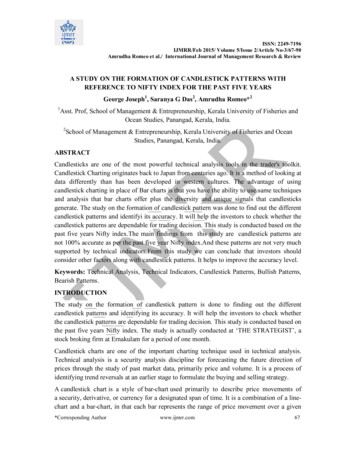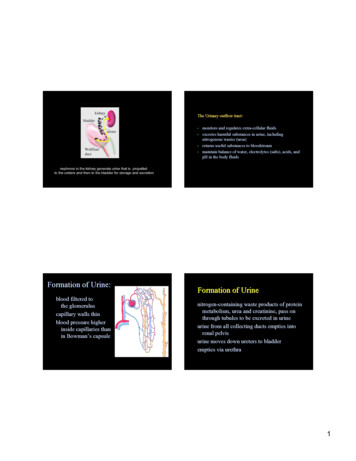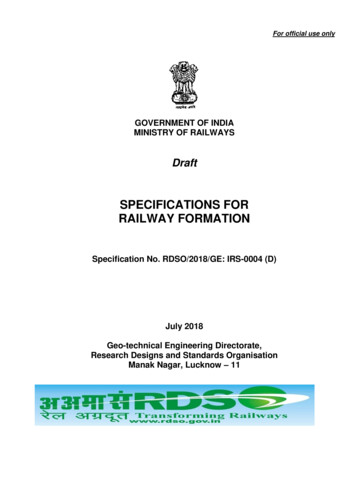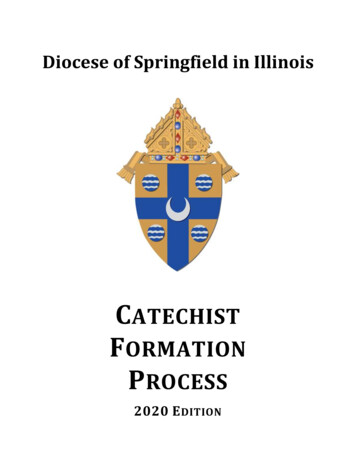
Transcription
ISSN: 2249-7196IJMRR/Feb 2015/ Volume 5/Issue 2/Article No-3/67-90Amrudha Romeo et al./ International Journal of Management Research & ReviewA STUDY ON THE FORMATION OF CANDLESTICK PATTERNS WITHREFERENCE TO NIFTY INDEX FOR THE PAST FIVE YEARSGeorge Joseph1, Saranya G Das2, Amrudha Romeo*21Asst. Prof, School of Management & Entrepreneurship, Kerala University of Fisheries andOcean Studies, Panangad, Kerala, India.2School of Management & Entrepreneurship, Kerala University of Fisheries and OceanStudies, Panangad, Kerala, India.ABSTRACTCandlesticks are one of the most powerful technical analysis tools in the trader's toolkit.Candlestick Charting originates back to Japan from centuries ago. It is a method of looking atdata differently than has been developed in western cultures. The advantage of usingcandlestick charting in place of Bar charts is that you have the ability to use same techniquesand analysis that bar charts offer plus the diversity and unique signals that candlesticksgenerate. The study on the formation of candlestick pattern was done to find out the differentcandlestick patterns and identifyi its accuracy. It will help the investors to check whether thecandlestick patterns are dependable for trading decision. This study is conducted based on thepast five years Nifty index.The main findings from this study are candlestick patterns arenot 100% accurate as per the past five year Nifty index.And these patterns are not very muchsupported by technical indicators.From this study we can conclude that investors shouldconsider other factors along with candlestick patterns. It helps to improve the accuracy level.Keywords: Technical Analysis, Technical Indicators, Candlestick Patterns, Bullish Patterns,Bearish Patterns.INTRODUCTIONThe study on the formation of candlestick pattern is done to finding out the differentcandlestick patterns and identifying its accuracy. It will help the investors to check whetherthe candlestick patterns are dependable for trading decision. This study is conducted based onthe past five years Nifty index. The study is actually conducted at ‘THE STRATEGIST’, astock broking firm at Ernakulam for a period of one month.Candlestick charts are one of the important charting technique used in technical analysis.Technical analysis is a security analysis discipline for forecasting the future direction ofprices through the study of past market data, primarily price and volume. It is a process ofidentifying trend reversals at an earlier stage to formulate the buying and selling strategy.A candlestick chart is a style of bar-chart used primarily to describe price movements ofa security, derivative, or currency for a designated span of time. It is a combination of a linechart and a bar-chart, in that each bar represents the range of price movement over a given*Corresponding Authorwww.ijmrr.com67
Amrudha Romeo et al./ International Journal of Management Research & Reviewtime interval. It is most often used in technical analysis of equity and currency price patterns.They appear superficially similar to box plots, but are unrelated. Candlestick charts arethought to have been developed in the 18th century by Munehisa Homma, Japanese ricetrader of financial instruments. They were introduced to the Western world by Steve Nison inhis book, Japanese Candlestick Charting Techniques. Candlesticks contain the same data as anormal bar chart but highlight the relationship between opening and closing prices. Theadvantage of candlestick charts is the ability to highlight trend weakness and reversal signalsthat may not be apparent on a normal bar chart. Candlestick Charts are an effective way ofvisualizing price movements.IMPORTANCE OF THE STUDYTechnical analysis is widely used by forex, equity, and commodity traders, to determine theshort term as well as the long term trends of the market. The scope of technical analysis isincreasing every day, as more and more people are trying to learn the skills of technicalanalysis to earn good returns. Scope of candlestick patterns as one of the tools used intechnical analysis;1. It helps investors and traders predict the trend of the market. Up trend, downtrend, andsideways moves of the market are easy to predict, with the help of chart analysis.2. Timing plays an important role in trading and investing. With the help of candlestickpatterns , traders and investors can predict the right time to enter and exit a trade therebyenabling good returns. Chart patterns, candlesticks, moving averages, Elliot wave analysis,and other indicators are very useful for traders to make entry and exit points.3. Candlestick patterns gives early signals and also paints a picture about the psychology ofinvestors and traders regarding what they are doing. Price-volume analysis also indicates themovement of market makers and their activities related to a particular market.4. Candlestick charts gives a quick result for traders who use 1 minute, 5 minutes, 30minutes, and 1 hour charts. For instance, the formation of a head and shoulder on 1 minuteand 5 minutes chart gives fast results, as compared to the daily charts.Technical charts provide a lot of information that helps the traders and investors build theirpositions and take trades. Information like support, resistance, chart pattern, momentum ofthe market, volatility, and trader’s psychology are just some examples of types of informationprovided by technical analysis and used by traders in the Forex marketSTATEMENT OF THE PROBLEMTo find whether candlestick patterns are useful in taking investment decisions by comparingits accuracy with technical indicators reference to Nifty index for the past five years.REVIEW OF LITERATURETechnical AnalysisTechnical analysis is a security analysis discipline for forecasting the future direction ofprices through the study of past market data, primarily price and volume. It is a process ofidentifying trend reversals at an earlier stage to formulate the buying and selling strategy.Copyright 2012 Published by IJMRR. All rights reserved68
Amrudha Romeo et al./ International Journal of Management Research & ReviewThe principles of technical analysis derive from the observation of financial markets overhundreds of years. The oldest known hints of technical analysis appear in Joseph de la Vega'saccounts of the Dutch markets in the 17th century. In Asia, the oldest example of technicalanalysis is thought to be a method developed by Homma Munehisa during early 18th centurywhich evolved into the use of candlestick techniques, and it is today a main charting tool.Dow Theory is based on the collected writings of Dow Jones co-founder and Editor CharlesDow, and inspired the use and development of modern technical analyse is from the end ofthe 19th century. Other pioneers of analysis techniques include Ralph Nelson Elliott andWilliam Delbert Gann who developed their respective techniques in the early 20th century.Many more technical tools and theories have been developed and enhanced in recent decades,with an increasing emphasis on computer-assisted techniques.Technical analysts seek to identify price patterns and trends in financial markets and attemptto exploit those patterns. While technicians use various methods and tools ,the study of pricecharts is primary .Technicians especially search for archetypal patterns, such as the wellknown head and shoulders or double top reversal patterns, study indicators such as movingaverages, and look for form such as lines of support, resistance, channels, and more obscureformations such as flags, pennants or balance days. Technical analysts also extensively useindicators, which are typically mathematical transformations of price or volume. Theseindicators are used to help determine whether an asset is trending, and if it is, its pricedirection. Technicians also look for relationships between price, volume and, in the case offutures, open interest. Examples include the relative strength index, and MACD(MovingAverage Convergence Divergence).Candlestick chartsA candlestick chart is a style of bar-chart used primarily to describe price movements ofa security, derivative, or currency for a designated span of time. It is a combination of a linechart and a bar-chart, in that each bar represents the range of price movement over a giventime interval. It is most often used in technical analysis of equity and currency price patterns.They appear superficially similar to box plots, but are unrelated.Candlestick charts are thought to have been developed in the 18th century by MunehisaHomma, Japanese rice trader of financial instruments. They were introduced to the Westernworld by Steve Nison in his book, Japanese Candlestick Charting Techniques. Candlestickscontain the same data as a normal bar chart but highlight the relationship between openingand closing prices. The advantage of candlestick charts is the ability to highlight trendweakness and reversal signals that may not be apparent on a normal bar chart. CandlestickCharts are an effective way of visualizing price movements. There are two basic candlesticks: Bullish Candle: When the close is higher than the open (usually green or white) Bearish Candle: When the close is lower than the open (usually red or black)Given below is a model of candlestick;Copyright 2012 Published by IJMRR. All rights reserved69
Amrudha Romeo et al./ International Journal of Management Research & ReviewFig 1: Model of CandlestickCandlestick PatternsThe power of Candlestick Charts is with multiple candlesticks forming reversal andcontinuation patterns. Following are the different candlestick patterns used in technicalanalysis: Bullish Engulfing PatternBearish Engulfing PatternDark Cloud CoverDojiDragonfly DojiEvening StarGravestone DojiHammerHanging ManHaramiInverted HammerMorning StarPiercing PatternShooting StarTweezer Tops and BottomsWindows1. Bullish Engulfing PatternThe Bullish Engulfing Candlestick Pattern is a bullish reversal pattern, usually occurring atthe bottom of a downtrend. The pattern consists of two Candlesticks: Smaller Bearish Candle Larger Bullish CandleCopyright 2012 Published by IJMRR. All rights reserved70
Amrudha Romeo et al./ International Journal of Management Research & ReviewFig 2: Bullish Engulfing Pattern2. Bearish Engulfing PatternThe Bearish Engulfing Candlestick Pattern is a bearish reversal pattern, usually occurring atthe top of an uptrend. The pattern consists of two Candlesticks: Smaller Bullish Candle Larger Bearish CandleFig 3: Model of bearish engulfing pattern3. Dark Cloud CoverDark Cloud Cover is a bearish candlestick reversal pattern, similar to the Bearish EngulfingPattern . There are two components of a Dark Cloud Cover formation: Bullish Candle Bearish CandleFig 4: Model of dark cloud coverCopyright 2012 Published by IJMRR. All rights reserved71
Amrudha Romeo et al./ International Journal of Management Research & Review4. DojiThe Doji is a powerful Candlestick formation, signifying indecision between bulls and bears.A Doji is quite often found at the bottom and top of trends and thus is considered as a sign ofpossible reversal of price direction, but the Doji can be viewed as a continuation pattern aswell.Fig 5: Model of DojiTwo powerful versions of the Doji formation are linked below: Dragonfly DojiThe Dragonfly Doji is a significant bullish reversal candlestick pattern that mainly occurs atthe bottom of downtrends.Fig 6: Model of dragonfly dojiGravestone DojiThe Gravestone Doji is a significant bearish reversal candlestick pattern that mainly occurs atthe top of uptrends. Fig 7: Model of gravestone doji5. Evening StarThe Evening Star Pattern is a bearish reversal pattern, usually occurring at the top of anuptrend. The pattern consists of three candlesticks:Copyright 2012 Published by IJMRR. All rights reserved72
Amrudha Romeo et al./ International Journal of Management Research & Review Large Bullish Candle Small Bullish or Bearish Candle Large Bearish CandleFig 8: Model of evening star6. HammerThe Hammer candlestick formation is a significant bullish reversal candlestick pattern thatmainly occurs at the bottom of downtrends.Fig 9: Model of hammer7. Hanging ManThe Hanging Man candlestick formation, as one could predict from the name, is a bearishsign. This pattern occurs mainly at the top of up trends and is a warning of a potentialreversal downward. It is important to emphasize that the Hanging Man pattern is a warning ofpotential price change, not a signal, in and of itself, to go short.Fig 10: Model of hanging manCopyright 2012 Published by IJMRR. All rights reserved73
Amrudha Romeo et al./ International Journal of Management Research & Review8. HaramiThe Harami Pattern is considered either bullish or bearish based on the criteria below: Bearish Harami: A bearish Harami occurs when there is a large bullish green candle onDay 1 followed by a smaller bearish or bullish candle on Day 2. The most important aspect ofthe bearish Harami is that prices gapped down on Day 2 and were unable to move higherback to the close of Day 1. This is a sign that uncertainty is entering the market. Bullish Harami: A bullish Harami occurs when there is a large bearish red candle on Day1 followed by a smaller bearish or bullish candle on Day 2. Again, the most important aspectof the bullish Harami is that prices gapped up on Day 2 and price was held up and unable tomove lower back to the bearish close of Day 1.The chart below of the Nifty shows anexample of both a bullish and bearish Harami candlestick pattern:9. Inverted HammerThe Inverted Hammer candlestick formation occurs mainly at the bottom of downtrends andis a warning of a potential reversal upward. It is important to note that the Inverted pattern isa warning of potential price change, not a signal, in and of itself, to buy.Fig 11: Model of inverted hammer10. Morning StarThe Morning Star Pattern is a bullish reversal pattern, usually occurring at the bottom of adowntrend.Fig 12: Model of morning starCopyright 2012 Published by IJMRR. All rights reserved74
Amrudha Romeo et al./ International Journal of Management Research & Review11. Piercing Line PatternThe Piercing Pattern is a bullish candlestick reversal pattern, similar to the Bullish EngulfingPattern. There are two components of a Piercing Pattern formation: Bearish CandleBullish CandleFig 13: Model of piercing pattern12. Shooting StarThe Shooting Star candlestick formation is a significant bearish reversal candlestick patternthat mainly occurs at the top of uptrends.Fig 14: Model of shooting star13. Tops and BottomsThe Tweezer Top formation is a bearish reversal pattern seen at the top of up trends and theTweezer Bottom formation is a bullish reversal pattern seen at the bottom of downtrends.Fig 15: Model of tweezersCopyright 2012 Published by IJMRR. All rights reserved75
Amrudha Romeo et al./ International Journal of Management Research & ReviewSometimes Tweezer Tops or Bottoms have three candlesticks.A bearish Tweezer Top occurs during an uptrend when bulls take prices higher, often closingthe day off near the highs (a bullish sign). However, on the second day, how traders feel (i.e.their sentiment) reverses completely. The market opens and goes straight down, ofteneliminating the entire gains of Day 1.The reverse, a bullish Tweezer Bottomoccurs during adowntrend when bears continue to take prices lower, usually closing the day near the lows (abearish sign). Nevertheless, Day 2 is completely opposite because prices open and gonowhere but upwards. This bullish advance on Day 2 sometimes eliminates all losses fromthe previous day.14. Windows (Gaps)Windows as they are called in Japanese Candlestick Charting, or Gaps, as they are called inthe west, are an important concept in technical analysis. Whenever, there is a gap (currentopen is not the same as prior closing price), that means that no price and no volumetransacted hands between the gap.Fig 16: Model of windowsA Gap Up occurs when the open of Day 2 is greater than the close of Day 1. Contrast, aGapDown occurs when the open of Day 2 is less than the close of Day one. There is muchpsychology behind gaps. Gaps can act as:Resistance: Once price gaps downward, the gap can act as long-term or even permanentresistance.Support: When prices gap upwards, the gap can act as support to prices in the future, eitherlong-term or permanently.MATERIALS AND METHODSTechnical IndicatorsOscillators are chart studies that are designed to show the strength of the current price inrelation to the recent price action. As such, they display the short term momentum of themarket, giving signals that the bias of the market is shifting before the price actually changesdirections. The principle upon which oscillators are based is that of regression to a mean.Essentially, a large part of a statistical sample should be within a certain number of standardCopyright 2012 Published by IJMRR. All rights reserved76
Amrudha Romeo et al./ International Journal of Management Research & Reviewdeviations from the mean of the sample, and if the price strays too far from this center, thenit will likely revert back to the rest of the sample. In terms of trading, the price should notrise or fall too far in too short a time. Oscillators are not usually displayed on the same graphas the price itself, but often placed at the bottom of the chart to show that the fluctuations donot occur on the same scale as the price movement.Relative Strength IndexRSI is an indicator that falls under the category of oscillators, and it is an extremely simpleindicator to use. RSI works well in range-bound markets, but it has limited value in trendingor breakout markets. RSI was created by Welles Wilder, who also created ATR, ParabolicSAR and other well-known indicators. Like all oscillators, RSI offer indications of when acurrency pair is overbought or oversold. RSI essentially calculates the strength of all upwardcandles(green) against the strength of all downward candles (red) over the course of thespecified time frame.If RSI is above 70, the pair is considered to be overbought. Some traders enter short at thispoint, but this can be dangerous as the price may still be rising. Enter short when the RSIcrosses back under 70, as this may indicate that the momentum has turned. If the RSI isbelow 30, the pair is considered to be oversold; enter when RSI crosses back above 30. Likemost oscillators, RSI works best when the market is range-bound – in other words, when themarket is expected to simply gravitate between an upper and lower level. In trending ormomentum-driven markets, using the overbought/oversold levels offered by RSI is generallyof limited value.RSI can also be used to signal when a trend is weakening. If a currency pairmakes new highs in its price but RSI does not – meaning there is divergence between theprice movement and RSI – it may signal that the trend is not strong, and that a reversal maybe imminent. If candlestick patterns confirm, a trader can use this as an opportunity to enter aposition.Moving Average Convergence DivergenceMACD is a commonly used technical indicator derived from exponential moving averagesthat can be used in both momentum and range bound markets. Like RSI it is an oscillatorplotted at the bottom of the chart, and it shows the momentum of the market relative to itsrecent history.ParametersThe MACD line is the difference between the 12 and 26 day EMA. The signal line is the 9day EMA of the MACD. Visually, the MACD consists of three elements: MACD line: This is simply the difference between the 12 and 26 day EMA. It is a lineplotted on the chart. Signal line: The signal line is the 9 day EMA of the MACD line. Like the MACD, it isaline plotted on the bottom of the chart. Histogram: The MACD histogram is simply a bar chart located at the bottom of the chart,where the MACD and signal lines are plotted. The histogram is simply a visual representationCopyright 2012 Published by IJMRR. All rights reserved77
Amrudha Romeo et al./ International Journal of Management Research & Reviewof the difference between the MACD and the signal line. The “zero” point of the histogram –meaning the point where the bars cross above and below – is referred to as the centerline.How to use it? Trade Signal: When the MACD crosses the signal line, a trade signal is issued. Traderscan enter positions following the direction of the MACD. Overbought/Oversold: No specific numbers indicate whether it is overbought oroversold, but if it is relatively far from its mean compared to its recent history, this maysuggest that it is due for a reversion. Divergence: When the pair makes new highs/lows but the MACD does not, this suggestsdivergence, and that the trend may in fact be weakening with a reversal in store.Nifty indexThe CNX Nifty is the flagship index on the National Stock Exchange of India Ltd. (NSE).The Index tracks the behavior of a portfolio of blue chip companies, the largest and mostliquid Indian securities. It includes 50 of the approximately 1600 companies listed on theNSE, captures approximately 65% of its float-adjusted market capitalization and is a truereflection of the Indian stock market.The CNX Nifty covers 21 sectors of the Indian economy and offers investment managersexposure to the Indian market in one efficient portfolio. The Index has been trading sinceApril 1996 and is well suited for benchmarking, index funds and index-based derivatives.The CNX Nifty is owned and managed by India Index Services and Products Ltd. (IISL).IISL is India’s first specialized company focused on an index as a core product.Tools used for analysisThe data collected are analyzed with the help of following tools; Candlestick chartsTechnical indicators;- Relative Strength Index (RSI)- Simple Moving Average (SMA)- Moving Average Convergence Divergence (MACD)RESULTS AND DISCUSSIONInorder to analyse the price movement of NIFTY, candlestick charts for the past fiveyears(1-5-2009 to 31-4-2014) is selected. From these charts we can identify differentcandlestick patterns and what does it meant for and also find out the indicators that supportcandlestick patterns.With reference to the past five years (1-5-2009 to 30-4-2014)dailyprice movementchart ofNifty, six candlestick patterns can be identified. They are:1. Bearish engulfing2. Bullish engulfing3. HaramiCopyright 2012 Published by IJMRR. All rights reserved78
Amrudha Romeo et al./ International Journal of Management Research & Review4.5.6.7.Shooting starHanging manHammerDark cloud cover.Bullish EngulfingThe Bullish Engulfing Candlestick Pattern is a bullish reversal pattern, usually occurring atthe bottom of a down trend.BULLISHENGULFINGFig 17: Formation of bullish engulfing, Source: NSEThe following table shows the information regarding the occurrence of bullish engulfingpattern for the last five years.Table 1: Actual Accuracy of bullish engulfingName of patternNumber ofoccurrenceTheoreticaloutcomeActual outcomeAccuracylevelbearish bullishBullish engulfing 15Bullish7853.33%From this table, it is clear that accuracy level is not high. Only 53.33%is the accuracy level ofthis pattern. It is not a trustable accuracy level to traders. The market expects a bullish trendby the occurrence of this pattern. But there is a 47% chance for happening bearish trend. So itis difficult to predict accurate price movement in the future. Bullish engulfing with other technical indicatorsTable 2: Bullish engulfing with other technical indicatorsName of patternNumber of occurrence ofthe patternBullish engulfing 38 Bullish engulfing with RSINumber of occurrence of patterns withthe support of technical indicatorsSMARSIMACD423If RSI is above 70, it is considered to be over bought and if the RSI is below 30, it isconsidered to be over sold. There are 15 bullish engulfing patterns are formed in the last fiveCopyright 2012 Published by IJMRR. All rights reserved79
Amrudha Romeo et al./ International Journal of Management Research & Reviewyears. Out of which only two of them are formed at the point of overbought /over sold shownby RSI. That means RSI is not supporting very well to this pattern. Therefore bullishengulfing pattern can’t predict the overbought /over sold with RSI. Bullish engulfing with SMAIt can be checked by observing that SMA is passing through any bullish engulfing pattern.From this we can understand that whether there is any chance for the formation of bullishengulfing pattern by hitting on the SMA line. By analysing the past five years candlestickcharts of Nifty, only four times SMA line is passing through the bullish engulfing pattern. Bullish engulfing with MACDWhen the MACD crosses the signal line, a trade signal is issued. The crossovers of MACDand signal line shows over bought or over sold signals. From the charts of NSE we cananalyze that ,any candlestick patterns formed at the point of crossover of MACD and signalline. From the past five years charts of NSE ,we can identify that there are only three bullishengulfing patterns are formed at the point of cross over of MACD and signal line. This showsthat the MACD is not a good supporting indicator for the bullish engulfing pattern. Becausein the past five years there are 38 total number of bullish engulfing patterns are formed andout of which only three of the patterns are supported by MACD.Bearish engulfingThe following chart shows the formation of bearish engulfing pattern on 12-10-2010. TheBearish Engulfing Pattern is a bearish reversal pattern, usually occurring at the top of anuptrend. In the chart also this pattern formed at the top of an uptrend.BEARISH ENGULFINGFig 18: Formation of bearish engulfing, Source:NSETable 3: Actual accuracy of bearish engulfingName ofpatternNumber arishCopyright 2012 Published by IJMRR. All rights reservedActual outcomebearish21bullish17Accuracylevel55.26%80
Amrudha Romeo et al./ International Journal of Management Research & ReviewThe table shows that the bearish engulfing pattern occurred 38 times in the past five years.The theoretical outcome of this pattern is bearish trend. But only 21 times its actual outcomebecame the theoretical outcome and 17 times it shows bullish trend after the occurrence ofthis pattern. The accuracy level is only 55.26%.That means it is not a high level of accuracy.Table 4: Bearish engulfing with other technical indicatorsName ofpatternNumber of occurrence ofthe patternBearish15engulfing Bearish engulfing with RSINumber of occurrence of patterns withthe support of technical indicatorsSMARSIMACD11014There are 15 bearish engulfing patterns are formed in the past five years. Out of which onlyten times bearish engulfing patterns are formed at the point of overbought /over sold shownby RSI. That means this pattern can’t predict the overbought /oversold with RSI. Bearish engulfing with SMAOut of 15 bearish engulfing patterns formed in the last five years ,only one pattern is hittingon the SMA line. That means the support of this indicator is very less in the case of bearishengulfing pattern. Bearish engulfing with MACDIn the past five years,14 bearish engulfing patterns are formed at the point of the crossover ofMACD and signal line. It shows that MACD is a very good supporting indicator of thispattern. Because out of 15 patterns, 14 of them are formed at the point of the crossover ofMACD and signal line. Bearish HaramiBEARISHHARAMI10-02-2012Fig 19: Formation of bearish harami , Source: NSETable 5: Actual accuracy of bearish haramiName of patternNumber ofoccurrenceTheoreticaloutcomeBearish harami18BearishCopyright 2012 Published by IJMRR. All rights reservedActual outcomebearish10bullish8Accuracylevel55.55%81
Amrudha Romeo et al./ International Journal of Management Research & ReviewIn the past five years bearish harami pattern has occurred 18 times and 10 times the actualoutcome became the theoretical outcome. Only 55.55% is the level of accuracy of thispattern. This is not a high level of accuracy.Bearish harami with other technical indicators;Table 6: Bearish harami with other technical indicatorsName ofpatternNumber of occurrence ofthe patternBearish18harami Bearish harami with RSINumber of occurrence of pattern withthe support of technical indicatorsSMARSIMACD114There are 18 bearish harami patterns are formed in the past five years. Out of which onepattern is formed at the point of overbought or over sold shown by RSI. That means thispattern can’t predict the overbought or oversold with RSI. Bearish harami with SMAThere are 18 bearish harami patterns formed in the last five years. Out of which SMA linepasses through only one pattern. This pattern also get very less support from the indicatorSMA. Bearish harami with MACDFrom the past five years charts of NSE , we can identify that there are only four bearishharami patterns are formed at the point of cross over of MACD and signal line. This showsthat the MACD is not a good supporting indicator for the bearish harami pattern. Because inthe past five years there are 18 total number of bearish harami patterns are formed and out ofwhich only three of the patterns are supported by MACD.Bullish shooting starTable 7: Actual accuracy of bullish shooting starName of patternNumber ofoccurrenceTheoretical Actual outcomeoutcomebearish bullishBullish30AccuracylevelBullish shooting30starThere are three bullish shooting stars occurred in the past five years. Theoretically bullishshooting star pattern shows the bullish trend of the market. But in the past five years actualoutcome of this pattern shows a bearish trend. The actual accuracy level of this pattern iszero. So it is not a trustable pattern for traders.Table 8: Bullish shooting star with other technical indicatorNumber ofNumber of occurrence of patterns withName ofpatternoccurrence of thethe support of technical indicatorspatternS
Bearish Patterns. INTRODUCTION The study on the formation of candlestick pattern is done to finding out the different candlestick patterns and identifying its accuracy. It will help the investors to check whether the candlestick patterns are dependable for trading decision. This study is conducted based on the past five years Nifty index.










